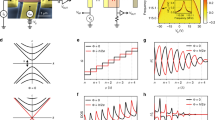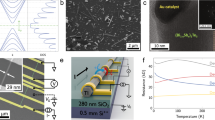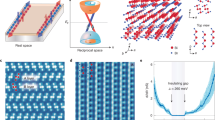Abstract
The spin-helical Dirac fermion topological surface states in a topological insulator nanowire or nanoribbon promise novel topological devices and exotic physics such as Majorana fermions. Here, we report local and non-local transport measurements in Bi2Te3 topological insulator nanoribbons that exhibit quasi-ballistic transport over ∼2 μm. The conductance versus axial magnetic flux Φ exhibits Aharonov–Bohm oscillations with maxima occurring alternately at half-integer or integer flux quanta (Φ0 = h/e, where h is Planck's constant and e is the electron charge) depending periodically on the gate-tuned Fermi wavevector (kF) with period 2π/C (where C is the nanoribbon circumference). The conductance versus gate voltage also exhibits kF-periodic oscillations, anti-correlated between Φ = 0 and Φ0/2. These oscillations enable us to probe the Bi2Te3 band structure, and are consistent with the circumferentially quantized topological surface states forming a series of one-dimensional subbands, which undergo periodic magnetic field-induced topological transitions with the disappearance/appearance of the gapless Dirac point with a one-dimensional spin helical mode.
This is a preview of subscription content, access via your institution
Access options
Subscribe to this journal
Receive 12 print issues and online access
$259.00 per year
only $21.58 per issue
Buy this article
- Purchase on Springer Link
- Instant access to full article PDF
Prices may be subject to local taxes which are calculated during checkout





Similar content being viewed by others
References
Hasan, M. Z. & Kane, C. L. Colloquium: topological insulators. Rev. Mod. Phys. 82, 3045–3067 (2010).
Qi, X.-L. & Zhang, S.-C. Topological insulators and superconductors. Rev. Mod. Phys. 83, 1057–1110 (2011).
Hsieh, D. et al. A tunable topological insulator in the spin helical Dirac transport regime. Nature 460, 1101–1105 (2009).
Chen, Y. L. et al. Experimental realization of a three-dimensional topological insulator, Bi2Te3 . Science 325, 178–181 (2009).
Zhang, T. et al. Experimental demonstration of topological surface states protected by time-reversal symmetry. Phys. Rev. Lett. 103, 266803 (2009).
Qu, D.-X., Hor, Y., Xiong, J., Cava, R. & Ong, N. Quantum oscillations and hall anomaly of surface states in the topological insulator Bi2Te3 . Science 329, 821–824 (2010).
Peng, H. L. et al. Aharonov–Bohm interference in topological insulator nanoribbons. Nature Mater. 9, 225–229 (2010).
Xiu, F. X. et al. Manipulating surface states in topological insulator nanoribbons. Nature Nanotech. 6, 216–221 (2011).
Tian, M. L. et al. Dual evidence of surface Dirac states in thin cylindrical topological insulator Bi2Te3 nanowires. Sci. Rep. 3, 1212 (2013).
Dufouleur, J. et al. Quasiballistic transport of Dirac fermions in a Bi2Se3 nanowire. Phys. Rev. Lett. 110, 186806 (2013).
Gooth, J., Hamdou, B., Dorn, A., Zierold, R. & Nielsch, K. Resolving the Dirac cone on the surface of Bi2Te3 topological insulator nanowires by field-effect measurements. Appl. Phys. Lett. 104, 243115 (2014).
Guanhua, Z. et al. Growth of topological insulator Bi2Se3 thin films on SrTiO3 with large tunability in chemical potential. Adv. Funct. Mater. 21, 2351–2355 (2011).
Tian, J. F. et al. Quantum and classical magnetoresistance in ambipolar topological insulator transistors with gate-tunable bulk and surface conduction. Sci. Rep. 4, 4859 (2014).
Bardarson, J. H., Brouwer, P. W. & Moore, J. E. Aharonov–Bohm oscillations in disordered topological insulator nanowires. Phys. Rev. Lett. 105, 156803 (2010).
Cook, A. & Franz, M. Majorana fermions in a topological–insulator nanowire proximity-coupled to an s-wave superconductor. Phys. Rev. B 84, 201105 (2011).
Cook, A. M., Vazifeh, M. M. & Franz, M. Stability of Majorana fermions in proximity-coupled topological insulator nanowires. Phys. Rev. B 86, 155431 (2012).
Rosenberg, G., Guo, H. M. & Franz, M. Wormhole effect in a strong topological insulator. Phys. Rev. B 82, 041104 (2010).
Zhang, Y. & Vishwanath, A. Anomalous Aharonov–Bohm conductance oscillations from topological insulator surface states. Phys. Rev. Lett. 105, 206601 (2010).
Ostrovsky, P. M., Gornyi, I. V. & Mirlin, A. D. Interaction-induced criticality in Z2 topological insulators. Phys. Rev. Lett. 105, 036803 (2010).
Hong, S. S., Zhang, Y., Cha, J. J., Qi, X. L. & Cui, Y. One-dimensional helical transport in topological insulator nanowire interferometers. Nano Lett. 14, 2815–2821 (2014).
Cho, S. et al. Aharonov–Bohm oscillations in a quasi-ballistic three-dimensional topological insulator nanowire. Nature Commun. 6, 7634 (2015).
De Juan, F., Ilan, R. & Bardarson, J. H. Robust transport signatures of topological superconductivity in topological insulator nanowires. Phys. Rev. Lett. 113, 107003 (2014).
Ilan, R., Bardarson, J. H., Sim, H.-S. & Moore, J. E. Detecting perfect transmission in Josephson junctions on the surface of three dimensional topological insulators. New J. Phys. 16, 053007 (2014).
Jauregui, L. A., Pettes, M. T., Rokhinson, L. P., Shi, L. & Chen, Y. P. Gate tunable relativistic mass and Berry's phase in topological insulator nanoribbon field effect devices. Sci. Rep. 5, 8452 (2015).
Chen, J. et al. Gate-voltage control of chemical potential and weak antilocalization in Bi2Se3 . Phys. Rev. Lett. 105, 176602 (2010).
Hamdou, B., Gooth, J., Dorn, A., Pippel, E. & Nielsch, K. Aharonov–Bohm oscillations and weak antilocalization in topological insulator Sb2Te3 nanowires. Appl. Phys. Lett. 102, 223110 (2013).
Matsuo, S. et al. Weak antilocalization and conductance fluctuation in a submicrometer-sized wire of epitaxial Bi2Se3 . Phys. Rev. B 85, 075440 (2012).
Ning, W. et al. One-dimensional weak antilocalization in single-crystal Bi2Te3 nanowires. Sci. Rep. 3, 1564 (2013).
Grbic, B. et al. Aharonov–Bohm oscillations in the presence of strong spin–orbit interactions. Phys. Rev. Lett. 99, 176803 (2007).
Yau, J. B., De Poortere, E. P. & Shayegan, M. Aharonov–Bohm oscillations with spin: evidence for Berry's phase. Phys. Rev. Lett. 88, 146801 (2002).
Yang, M. J., Yang, C. H. & Lyanda-Geller, Y. B. Quantum beating in the conductance of ballistic rings. Physica E 22, 304–307 (2004).
Buttiker, M. Four-terminal phase-coherent conductance. Phys. Rev. Lett. 57, 1761 (1986).
Couto, N., Sacépé, B. & Morpurgo, A. Transport through graphene on SrTiO3 . Phys. Rev. Lett. 107, 225501 (2011).
Bardarson, J. H. & Moore, J. E. Quantum interference and Aharonov–Bohm oscillations in topological insulators. Rep. Prog. Phys. 76, 056501 (2013).
Gao, B., Chen, Y. F., Fuhrer, M. S., Glattli, D. C. & Bachtold, A. Four-point resistance of individual single-wall carbon nanotubes. Phys. Rev. Lett. 95, 196802 (2005).
Kobayashi, K., Aikawa, H., Katsumoto, S. & Iye, Y. Probe-configuration-dependent decoherence in an Aharonov–Bohm ring. J. Phys. Soc. Jpn 71, 2094 (2002).
Hansen, A. E., Kristensen, A., Pedersen, S., Sorensen, C. B. & Lindelof, P. E. Mesoscopic decoherence in Aharonov–Bohm rings. Phys. Rev. B 64, 045327 (2001).
Ferrier, M. et al. Geometrical dependence of decoherence by electronic interactions in a GaAs/GaAlAs square network. Phys. Rev. Lett. 100, 146802 (2008).
Ludwig, T. & Mirlin, A. D. Interaction-induced dephasing of Aharonov–Bohm oscillations. Phys. Rev. B 69, 193306 (2004).
Texier, C. & Montambaux, G. Dephasing due to electron–electron interaction in a diffusive ring. Phys. Rev. B 72, 115327 (2005).
Buchholz, S. S., Fischer, S. F., Kunze, U., Reuter, D. & Wieck, A. D. Nonlocal Aharonov–Bohm conductance oscillations in an asymmetric quantum ring. Appl. Phys. Lett. 94, 022107 (2009).
Yacoby, A., Schuster, R. & Heiblum, M. Phase rigidity and h/2e oscillations in a single-ring Aharonov–Bohm experiment. Phys. Rev. B 53, 9583 (1996).
Acknowledgements
TI material synthesis, characterization and part of the magneto-transport studies were supported by a DARPA MESO programme (grant no. N66001-11-1-4107). Part of the FET fabrication and characterizations were supported by Intel Corporation. The later stage of this work at Purdue was also supported in part by the National Science Foundation (DMR-1410942). L.A.J. acknowledges support by an Intel PhD fellowship and a Purdue Center for Topological Materials fellowship. L.P.R. was supported by the U.S. Department of Energy, Office of Science, Office of Basic Energy Sciences under Award Number DE-SC-0008630. Y.P.C. and L.A.J. thank M. Franz, J.H. Bardarson, T. Kubis and F.W. Chen for discussions.
Author information
Authors and Affiliations
Contributions
L.A.J. designed and fabricated the devices and carried out the measurements and data analysis. M.T.P. and L.S. synthesized the Bi2Te3 nanoribbons and performed structural analysis. L.P.R. helped with the low-temperature transport experiment. Y.P.C. supervised the research. L.A.J and Y.P.C. wrote the paper with contributions from all co-authors.
Corresponding author
Ethics declarations
Competing interests
The authors declare no competing financial interests.
Supplementary information
Supplementary information
Supplementary information (PDF 1914 kb)
Rights and permissions
About this article
Cite this article
Jauregui, L., Pettes, M., Rokhinson, L. et al. Magnetic field-induced helical mode and topological transitions in a topological insulator nanoribbon. Nature Nanotech 11, 345–351 (2016). https://doi.org/10.1038/nnano.2015.293
Received:
Accepted:
Published:
Issue Date:
DOI: https://doi.org/10.1038/nnano.2015.293
This article is cited by
-
The quantum oscillations in different probe configurations in the \(\hbox {BiSbTe}_{{3}}\) topological insulator macroflake
Scientific Reports (2022)
-
Proximity-induced superconductivity in (Bi1−xSbx)2Te3 topological-insulator nanowires
Communications Materials (2022)
-
Quantum confinement of the Dirac surface states in topological-insulator nanowires
Nature Communications (2021)
-
In-plane magnetic field-driven symmetry breaking in topological insulator-based three-terminal junctions
Communications Materials (2021)
-
Cycling Fermi arc electrons with Weyl orbits
Nature Reviews Physics (2021)



